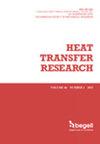一项新颖的机器学习研究:利用基于机油的铜银纳米流体最大化抛物槽太阳能集热器的效率
IF 1.6
4区 工程技术
Q3 THERMODYNAMICS
引用次数: 0
摘要
利用机器学习估算抛物面槽式太阳能集热器的传热参数对于提高这些可再生能源系统的效率和性能、优化其设计和运行、降低成本以及增加太阳能作为可持续能源的使用至关重要。本研究利用机器学习方法研究了两种不同的纳米流体在热跃迁条件下流经直面多孔介质的传热特性。对于抛物面槽式太阳能集热器中的流动,考虑了从银基和铜基机油中获得的两种不同的纳米流体。通过非线性表面张力、热辐射和卡塔尼奥-克里斯托夫热流获得了流动特性,并利用这些特性计算了热边界层中的热流。建立了一个神经网络结构来估算为分析流动特性而确定的表皮摩擦力和努塞尔特数。多层神经网络共使用了 30 组数据,分为训练、验证和测试三组。网络模型的输入层有 15 个隐层神经元,定义了 10 个参数,在输出层对两种不同的纳米流体得出了四种不同的结果。通过几个性能参数对所建立的神经网络模型的预测性能进行了全面研究。研究结果表明,所建立的人工神经网络可以预测从银基和铜基机油中获得的两种不同纳米流体的传热特性,偏差率小于 0.06%。本文章由计算机程序翻译,如有差异,请以英文原文为准。
A NOVEL MACHINE LEARNING STUDY: MAXIMIZING THE EFFICIENCY OF PARABOLIC TROUGH SOLAR COLLECTORS WITH ENGINE OIL-BASED COPPER AND SILVER NANOFLUIDS
Estimating the heat transfer parameters of parabolic trough solar collectors with machine learning is crucial for
improving the efficiency and performance of these renewable energy systems, optimizing their design and operation,
and reducing costs while increasing the use of solar energy as a sustainable power source. In this study, the heat transfer characteristics of two different nanofluids flowing through the porous media in a straight plane underneath thermal jump conditions were investigated by machine learning methods. For the flow in the parabolic trough solar collector,
two different nanofluids obtained from silver- and copper-based motor oil are considered. Flow characteristics were
obtained by nonlinear surface tension, thermal radiation, and Cattaneo–Christov heat flow, which was used to calculate
the heat flow in the thermal boundary layer. A neural network structure was established to estimate the skin friction
and Nusselt number determined for the analysis of the flow characteristic. The data used in the multilayer neural
network, which was developed using a total of 30 data sets, were divided into three groups as training, validation, and
testing. In the input layer of the network model with 15 neurons in the hidden layer, 10 parameters were defined and
four different results were obtained for two different nanofluids in the output layer. The prediction performance of the established neural network model has been comprehensively studied by means of several performance parameters. The study findings presented that the established artificial neural network can predict the heat transfer characteristics of two different nanofluids obtained from silver- and copper-based motor oil with deviation rates less than 0.06%.
求助全文
通过发布文献求助,成功后即可免费获取论文全文。
去求助
来源期刊

Heat Transfer Research
工程技术-热力学
CiteScore
3.10
自引率
23.50%
发文量
102
审稿时长
13.2 months
期刊介绍:
Heat Transfer Research (ISSN1064-2285) presents archived theoretical, applied, and experimental papers selected globally. Selected papers from technical conference proceedings and academic laboratory reports are also published. Papers are selected and reviewed by a group of expert associate editors, guided by a distinguished advisory board, and represent the best of current work in the field. Heat Transfer Research is published under an exclusive license to Begell House, Inc., in full compliance with the International Copyright Convention. Subjects covered in Heat Transfer Research encompass the entire field of heat transfer and relevant areas of fluid dynamics, including conduction, convection and radiation, phase change phenomena including boiling and solidification, heat exchanger design and testing, heat transfer in nuclear reactors, mass transfer, geothermal heat recovery, multi-scale heat transfer, heat and mass transfer in alternative energy systems, and thermophysical properties of materials.
 求助内容:
求助内容: 应助结果提醒方式:
应助结果提醒方式:


